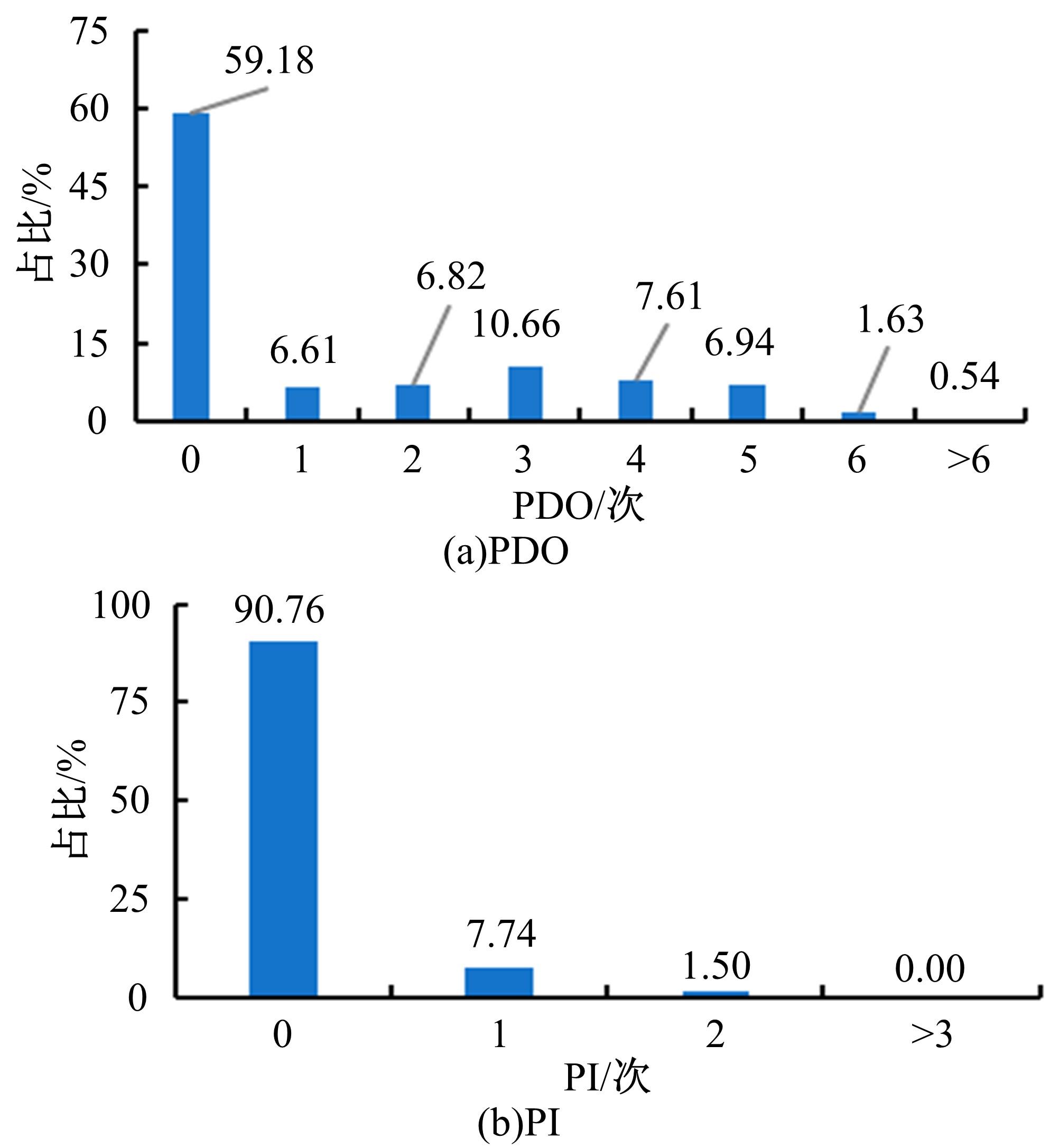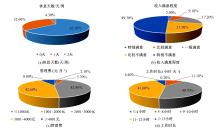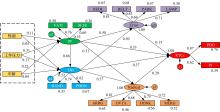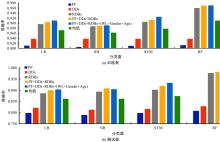吉林大学学报(工学版) ›› 2023, Vol. 53 ›› Issue (2): 457-467.doi: 10.13229/j.cnki.jdxbgxb20210614
基于MIMIC与机器学习的出租车驾驶员交通事故诱因分析
潘恒彦1( ),张文会2,梁婷婷3,彭志鹏1,高维4,王永岗1(
),张文会2,梁婷婷3,彭志鹏1,高维4,王永岗1( )
)
- 1.长安大学 运输工程学院,西安 710064
2.东北林业大学 交通学院,哈尔滨 150040
3.西安交通工程学院 土木工程学院,西安 710399
4.哈尔滨工业大学 交通科学与工程学院,哈尔滨 150090
Inducement analysis of taxi drivers' traffic accidents based on MIMIC and machine learning
Heng-yan PAN1( ),Wen-hui ZHANG2,Ting-ting LIANG3,Zhi-peng PENG1,Wei GAO4,Yong-gang WANG1(
),Wen-hui ZHANG2,Ting-ting LIANG3,Zhi-peng PENG1,Wei GAO4,Yong-gang WANG1( )
)
- 1.College of Transportation Engineering,Chang'an University,Xi'an 710064,China
2.School of Traffic and Transportation,Northeast Forestry University,Harbin 150040,China
3.School of Civil Engineering,Xi'an Traffic Engineering Institute,Xi'an 710399,China
4.School of Transportation Science and Engineering,Harbin Institute of Technology,Harbin 150090,China
摘要:
通过调查问卷收集2391名出租车驾驶员个体属性、身体疲劳感知、工作压力、风险驾驶行为和交通事故经历的相关信息。运用多指标多原因(MIMIC)模型进行路径分析,探究身体疲劳感知、风险驾驶行为对交通事故的诱发效应,验证性别、年龄、工作压力的原因变量对身体疲劳感知、分心驾驶行为的影响作用。选取逻辑回归、朴素贝叶斯、支持向量机、随机森林4种机器学习算法对出租车事故进行预测。结果表明:身体疲劳感知、过失性驾驶行为、激进性驾驶行为与分心驾驶行为的提高能够导致事故率的提高,性别、年龄、工作压力会对身体疲劳感知与分心驾驶行为的频次产生影响。基于机器学习的事故预测模型效果极佳,其中随机森林的预测效果最好,使用单一特征变量“风险驾驶行为”、“分心驾驶行为”、“身体疲劳感知”的预测精度尚可接受。当引入“工作压力”、“年龄”、“性别”的个人属性指标时,预测精度进一步提高。
中图分类号:
- U491
| 1 | Wang Y, Li L, Prato C G. The relation between working conditions, aberrant driving behaviour and crash propensity among taxi drivers in China[J]. Accident Analysis & Prevention, 2019, 126: 17-24. |
| 2 | Peng Z, Zhang H, Wang Y. Work-related factors, fatigue, risky behaviours and traffic accidents among taxi drivers: a comparative analysis among age groups[J]. International Journal of Injury Control and Safety Promotion, 2021, 28(1): 58-67. |
| 3 | Wang Y, Li M, Du J, et al. Prevention of taxi accidents in xi'an, China: what matters most?[J]. Central European Journal of Public Health, 2015, 23(1): 77-83. |
| 4 | Routley V, Ozanne S J, Qin Y,et al.Taxi driver seat belt wearing in nanjing,China[J].Journal of Safety Research, 2009, 40(6): 449-454. |
| 5 | Ma M, Yan X, Huang H,et al.Safety of public transportation occupational drivers: risk perception, attitudes, and driving behavior[J]. Transportation Research Record, 2010(1): 72-79. |
| 6 | Shi J, Li T, Li X, et al. A survey of taxi drivers' aberrant driving behavior in Beijing[J]. Journal of Transportation Safety & Security, 2014, 6(1): 34-43. |
| 7 | Meng F, Wong S C, Yan W,et al.Temporal patterns of driving fatigue and driving performance among male taxi drivers in hong kong: a driving simulator approach[J]. Accident Analysis & Prevention, 2019, 125: 7-13. |
| 8 | Lee S, Kim J, Park J, et al. Deep-learning-based prediction of high-risk taxi drivers using wellness data[J]. International Journal of Environmental Research and Public Health, 2020, 17(24): 17249505. |
| 9 | Peng Z, Wang Y, Luo X. How does financial burden influence the crash rate among taxi drivers? a self-reported questionnaire study in China[J]. Traffic Injury Prevention, 2020, 21(5): 324-329. |
| 10 | Sani S R H, Tabibi Z, Fassrdi J S, et al. Aggression, emotional self-regulation, attentional bias, and cognitive inhibition predict risky driving behavior[J]. Accident Analysis & Prevention, 2017, 109: 78-88. |
| 11 | Kim D, Sul J. Analysis of pedestrian accidents based on the in-vehicle real accident videos[C]∥Proceedings of 23rd International Technical Conference on the Enhanced Safety of Vehicles, Seoul, Korea, 2013: 1-12. |
| 12 | Akerstedt T, Anund A, Axelsson J,et al.Subjective sleepiness is a sensitive indicator of insufficient sleep and impaired waking function[J]. Journal of Sleep Research, 2014, 23(3): 240-252. |
| 13 | Boksem M A, Meijman T F, Lorist M M. Effects of mental fatigue on attention: an ERP study[J]. Cognitive Brain Research, 2005, 25(1): 107-116. |
| 14 | Ting P H, Hwang J R, Doong J L, et al. Driver fatigue and highway driving: a simulator study[J]. Physiology & Behavior, 2008, 94(3): 448-453. |
| 15 | Sullman M J, Stephens A N, Kuzu D. The expression of anger amongst Turkish taxi drivers[J]. Accident Analysis & Prevention, 2013, 56: 42-50. |
| 16 | Brandenburg S, Oehl M, Seigies K.German taxi drivers' experiences and expressions of driving anger: are the driving anger scale and the driving anger expression inventory valid measures?[J]. Traffic Injury Prevention, 2017, 18(8): 807-812. |
| 17 | 程国柱,冯思鹤,史伯睿.机动车非职业驾驶人事故倾向性测评方法[J].哈尔滨工业大学学报,2021,53(9): 99-106. |
| Cheng Guo-zhu, Feng Si-he, Shi Bo-rui.Evaluation method for accident proneness of non-professional motor vehicle drivers[J]. Journal of Harbin Institute of Technology, 2021, 53(9): 99-106. | |
| 18 | Asefa N G, Ingale L, Shumey A,et al.Prevalence and factors associated with road traffic crash among taxi drivers in Mekelle Town, Northern Ethiopia, 2014: a cross sectional study[J]. Plos One, 2015, 10(3): 118675. |
| 19 | Mokarami M, Alizadeh S S, Pordanjani T R, et al. The relationship between organizational safety culture and unsafe behaviors, and accidents among public transport bus drivers using structural equation modeling[J]. Transportation Research Part F: Traffic Psychology and Behaviour, 2019, 65: 46-55. |
| 20 | Cheng A S K, Ting K H, Liu K P, et al. Impulsivity and risky decision making among taxi drivers in Hong kong: an event-related potential study[J]. Accident Analysis & Prevention, 2015, 95: 387-394. |
| 21 | Burns P, Wilde J S. Risk taking in male taxi drivers: relationships among personality, observational data and driver records[J]. Personality and Individual Differences, 1995, 18(2): 267-278. |
| 22 | 江欣国,周悦,夏亮,等.出租车驾驶员交通违法行为演化博弈模型[J].西南交通大学学报, 2019, 54(6): 1121-1128, 1118. |
| Jiang Xin-guo, Zhou Yue, Xia Liang,et al.Evolutionary game model of traffic violations among taxi drivers[J]. Journal of Southwest Jiaotong University, 2019, 54(6): 1121-1128, 1118. | |
| 23 | 万平,吴超仲,马晓凤.基于ROC曲线和驾驶行为特征的驾驶愤怒强度判别阈值[J].吉林大学学报:工学版, 2020, 50(1): 121-131. |
| Wan Ping, Wu Chao-zhong, Ma Xiao-feng.Discriminating threshold of driving anger intensity based on driving behavior features by ROC curve analysis[J]. Journal of Jilin University(Engineering and Technology Edition), 2020, 50(1): 121-131. |
| [1] | 贺宜,孙昌鑫,彭建华,吴超仲,江亮,马明. 电动载货三轮车风险行为及影响因素分析[J]. 吉林大学学报(工学版), 2023, 53(2): 413-420. |
| [2] | 朱洁玉,马艳丽. 合流区域多车交互风险实时评估方法[J]. 吉林大学学报(工学版), 2022, 52(7): 1574-1581. |
| [3] | 彭涛,方锐,刘兴亮,王海玮,庞彦伟,许洪国,刘福聚,王涛. 基于典型事故场景的雪天高速换道自动驾驶策略[J]. 吉林大学学报(工学版), 2022, 52(11): 2558-2567. |
| [4] | 段亮,宋春元,刘超,魏苇,吕成吉. 基于机器学习的高速列车轴承温度状态识别[J]. 吉林大学学报(工学版), 2022, 52(1): 53-62. |
| [5] | 李光松,李文清,李青. 基于随机性特征的加密和压缩流量分类[J]. 吉林大学学报(工学版), 2021, 51(4): 1375-1386. |
| [6] | 朱小龙,谢忠. 基于机器学习的地理空间数据抽取算法[J]. 吉林大学学报(工学版), 2021, 51(3): 1011-1016. |
| [7] | 程国柱,程瑞,徐亮,张文会. 基于乘员伤害分析的公路路侧事故风险评价[J]. 吉林大学学报(工学版), 2021, 51(3): 875-885. |
| [8] | 李阳,李硕,井丽巍. 基于贝叶斯模型与机器学习算法的金融风险网络评估模型[J]. 吉林大学学报(工学版), 2020, 50(5): 1862-1869. |
| [9] | 方伟,黄羿,马新强. 基于机器学习的虚拟网络感知数据缺陷自动检测[J]. 吉林大学学报(工学版), 2020, 50(5): 1844-1849. |
| [10] | 刘洲洲,尹文晓,张倩昀,彭寒. 基于离散优化算法和机器学习的传感云入侵检测[J]. 吉林大学学报(工学版), 2020, 50(2): 692-702. |
| [11] | 王露,刘玉雯,陈红. 侧风下峡谷桥隧连接段汽车的行驶特性[J]. 吉林大学学报(工学版), 2019, 49(3): 736-748. |
| [12] | 尹超英,邵春福,王晓全. 考虑停车可用性的建成环境对小汽车通勤出行的影响[J]. 吉林大学学报(工学版), 2019, 49(3): 714-719. |
| [13] | 代存杰,李引珍,马昌喜,柴获,牟海波. 不确定条件下危险品配送路线多准则优化[J]. 吉林大学学报(工学版), 2018, 48(6): 1694-1702. |
| [14] | 王芳荣, 郭柏苍, 金立生, 高琳琳, 岳欣羽. 次任务驾驶安全评价指标筛选及其权值计算[J]. 吉林大学学报(工学版), 2017, 47(6): 1710-1715. |
| [15] | 谭立东, 刘丹, 李文军. 基于蝇复眼的交通事故现场全景图像阵列仿生设计[J]. 吉林大学学报(工学版), 2017, 47(6): 1738-1744. |
|









